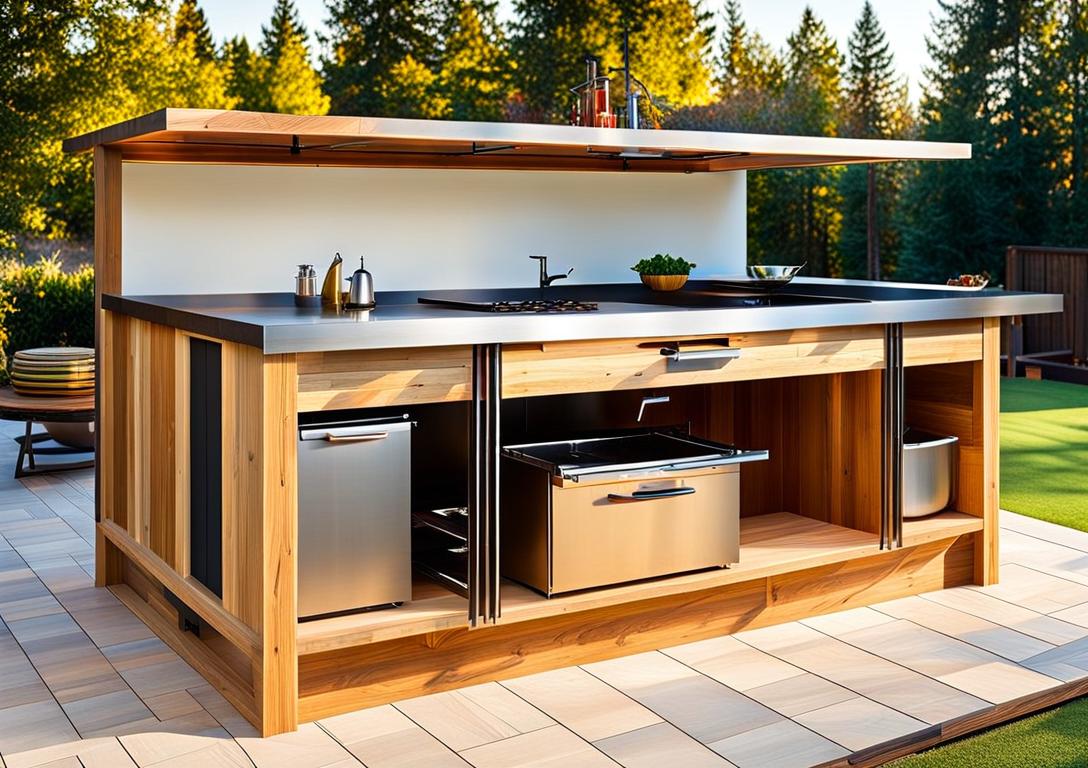Designing an outdoor kitchen can elevate your backyard into a fully functional cooking and entertainment hub. But one of the most important decisions you’ll make is selecting the right material for your modern outdoor kitchen. The key contenders? Solid wood, plywood, and stainless steel. Each material has its unique strengths and weaknesses, but when it comes to delivering maximum durability and style, stainless steel often comes out ahead.
In this blog, we’ll compare these three popular materials, break down their pros and cons, and highlight their key differences to help you decide which one is best suited for your outdoor space. Plus, we’ll focus on why stainless steel is the ultimate champion for outdoor kitchens.
Key Factors in Choosing the Right Material
When comparing solid wood, plywood, and stainless steel, it’s essential to evaluate how well each material performs in key areas like:
Durability – Can it handle different weather conditions?
Maintenance – How much effort will it take to keep it looking great?
Aesthetic Appeal – Does it complement your outdoor space’s design?
Cost and Longevity – Does it offer good value for your investment?
Let’s take a closer look at how each material stacks up.
- Solid Wood Outdoor Kitchens
Solid wood is a timeless choice known for its natural beauty and warmth. But while it has undeniable charm, its practicality in an outdoor setting is often limited.
Pros
Rich Appearance: Solid wood adds an organic, rustic aesthetic that complements natural landscaping and outdoor spaces.
Customizable: Can be sanded, stained, or painted to match your design preferences.
Premium Feel: Certain hardwoods, like teak or cedar, bring elegance and a luxurious feel to outdoor kitchens.
Cons
Weather Vulnerabilities:
Wood is susceptible to warping, cracking, and rotting when exposed to excessive moisture, heat, and sunlight.
Even durable hardwoods like teak require regular maintenance to remain weather-resistant.
High Maintenance:
To withstand outdoor conditions, wood must be regularly stained or sealed, adding ongoing time and costs.
Cost: High-quality hardwoods are expensive and, when paired with maintenance costs, may not be the most economical option.
Solid wood shines in aesthetics but falls short when it comes to long-term durability and minimal maintenance, especially in exposed outdoor environments.
- Plywood Outdoor Kitchens
Plywood, a manufactured wood product, is a more affordable alternative to solid wood and offers some flexibility in design. But is it well-suited for outdoor kitchens?
Pros
Affordability: Plywood is less expensive than solid wood, making it a budget-friendly choice.
Lightweight and Versatile: Plywood is easy to cut and shape, allowing for creative and detailed designs.
Improved Durability (With Treatments): Marine-grade plywood is designed to handle higher moisture levels than standard plywood.
Cons
Less Durable Overall:
While marine-grade plywood resists moisture better, it is still prone to delamination, swelling, and warping over time.
Long-term exposure to rain, humidity, and heat can significantly diminish its integrity.
Maintenance Required: To extend its lifespan, plywood must be sealed and waterproofed periodically.
Appearance: Even with veneers or laminates, plywood lacks the high-end appeal of solid wood or stainless steel.
Plywood may work for temporary or semi-sheltered outdoor kitchens, but its vulnerability to weather makes it a less durable choice for long-term use.
- Stainless Steel Outdoor Kitchens
Stainless steel is the gold standard for outdoor kitchens—and for good reason. This modern and durable material is engineered to thrive in outdoor environments while maintaining a sleek and stylish look.
Pros
- Superior Durability
Stainless steel is designed to withstand the harshest elements:
Weatherproof: High-quality stainless steel, such as 304-grade or 316-grade, resists rust and corrosion even in humid or coastal environments.
Heat Tolerance: It doesn’t crack, warp, or degrade when exposed to high heat, making it ideal for grilling areas.
Impact-Resistant: Unlike wood or plywood, stainless steel doesn’t chip, crack, or split under pressure.
- Minimal Maintenance
Cleaning is simple—just a quick wipe with soapy water or stainless steel cleaner.
No staining, sanding, or sealing is required, making it a low-maintenance option compared to wood or plywood.
- Modern Aesthetic
Stainless steel delivers a contemporary and professional look, adding a luxury feel to your outdoor kitchen.
Its sleek, metallic finish can pair beautifully with other materials, such as natural stone, concrete, or tile countertops.
- Hygienic and Sanitary
Stainless steel is non-porous, which inhibits the growth of bacteria and mold—an important factor for food preparation areas.
- Long-Term Investment
While the initial cost may be higher, stainless steel’s durability, low maintenance, and long lifespan make it a cost-effective choice in the long run.
Cons
While stainless steel outshines other materials in many areas, there are a few considerations to keep in mind:
Upfront Cost: Premium stainless steel materials such as 304-grade or 316-grade are more expensive, but their longevity offsets the investment.
Heat Absorption: In direct sunlight, stainless steel can become hot to the touch. Positioning your kitchen in shaded areas or incorporating pergolas can mitigate this.
Smudges and Scratches: Stainless steel is prone to fingerprints and minor scratches, but these are generally easy to clean or buff out.
Despite these minor challenges, stainless steel offers an unbeatable combination of style, durability, and low maintenance, making it the best option for outdoor kitchens.
Why Stainless Steel Wins
If you’re designing an outdoor kitchen to last, stainless steel is a no-brainer. It outshines solid wood and plywood when it comes to:
Weather Resistance: No cracking, warping, or rotting.
Ease of Maintenance: No resealing or frequent repairs required.
Longevity: Decades of reliable use with minimal upkeep.
Style: A sleek, modern design that elevates your outdoor aesthetic.
Choosing the right material for your outdoor kitchen is crucial to ensuring its durability, usability, and appearance. While solid wood and plywood may appeal to limited budgets or specific design aesthetics, stainless steel is the all-around winner for its strength, low maintenance, and timeless charm.

 How a General Contractor Manages Large Renovation Projects
How a General Contractor Manages Large Renovation Projects  Why Ongoing Support Is More Valuable Than a Low Initial Price When Installing Stairlifts In Scotland?
Why Ongoing Support Is More Valuable Than a Low Initial Price When Installing Stairlifts In Scotland?  How To Repair The Roof Penetration That Causes Vent Pipe Leaks
How To Repair The Roof Penetration That Causes Vent Pipe Leaks  Transform Your San Francisco Outdoor Space with Expert Paver Installation
Transform Your San Francisco Outdoor Space with Expert Paver Installation  What Materials Are Recovered in Mattress Recycling?
What Materials Are Recovered in Mattress Recycling?  DSCR Loans Explained: Debt Service Coverage Ratio Made Simple
DSCR Loans Explained: Debt Service Coverage Ratio Made Simple  Where to Buy Laticrete Spectralock Pro Grout?
Where to Buy Laticrete Spectralock Pro Grout?  The Bathroom Renovation Secrets Kitchener-Waterloo Homeowners Should Know
The Bathroom Renovation Secrets Kitchener-Waterloo Homeowners Should Know 